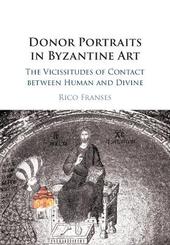
|
Donor Portraits in Byzantine Art: The Vicissitudes of Contact between Human and Divine
Paperback / softback
Main Details
| Title |
Donor Portraits in Byzantine Art: The Vicissitudes of Contact between Human and Divine
|
| Authors and Contributors |
By (author) Rico Franses
|
| Physical Properties |
| Format:Paperback / softback | | Pages:261 |
|
| Category/Genre | Art History
Byzantine and medieval art c 500 CE to c 1400 |
|---|
| ISBN/Barcode |
9781108407588
|
| Classifications | Dewey:709.0214 |
|---|
| Audience | | Professional & Vocational | |
|---|
| Illustrations |
Worked examples or Exercises; 64 Halftones, black and white
|
|
Publishing Details |
| Publisher |
Cambridge University Press
|
| Imprint |
Cambridge University Press
|
| NZ Release Date |
31 March 2023 |
| Publication Country |
United Kingdom
|
Description
This book explores the range of images in Byzantine art known as donor portraits. It concentrates on the distinctive, supplicatory contact shown between ordinary, mortal figures and their holy, supernatural interlocutors. The topic is approached from a range of perspectives, including art history, theology, structuralist and post-structuralist anthropological theory, and contemporary symbol and metaphor theory. Rico Franses argues that the term 'donor portraits' is inappropriate for the category of images to which it conventionally refers and proposes an alternative title for the category, contact portraits. He contends that the most important feature of the scenes consists in the active role that they play within the belief systems of the supplicants. They are best conceived of not simply as passive expressions of stable, pre-existing ideas and concepts, but as dynamic proponents in a fraught, constantly shifting landscape. The book is important for all scholars and students of Byzantine art and religion.
Author Biography
Rico Franses is an Associate Professor in the Department of Fine Arts and Art History, American University of Beirut, and Director of the University Art Galleries and Collections.
Reviews'This is a book that takes a broadly synchronic look across the Byzantine world, a view that different works of art in different media from different times and places nonetheless speak to the same broad Christian world-view, to similar structures ... This is a perspective that makes us think and it makes us question, and that is what the best scholarship should do.' Liz James, The English Historical Review
|